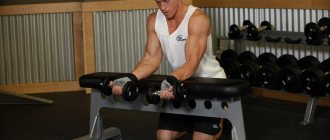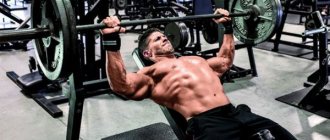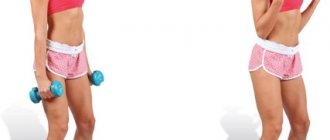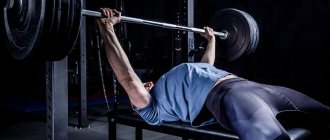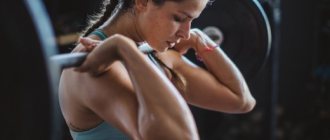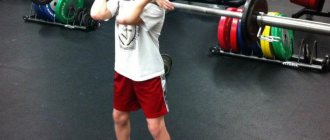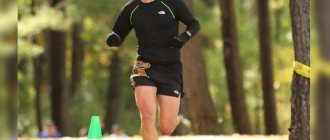Even if you just like to go for a light jog sometimes, and you don’t strive to conquer the sports Olympus, strength exercises for running will help strengthen your body and make your body more toned.
Running develops almost all muscle groups. The correct training process is not only the running itself, but also a large number of special exercises that develop muscles, strengthen ligaments and contribute to the development of speed and strength qualities. To make training more enjoyable and effective every day, all experts without exception recommend, in addition to the running component of the training process, to regularly do a set of SBU (special running exercises) and a set of SS (strength exercises). Both are needed to master the correct running technique. Trained muscles will allow you to run faster, more technically and more comfortably.
Sports doctors like to repeat that strong muscles support strong ligaments. Systematic strength training increases the volume and strength of muscle fibers. In addition, they strengthen ligaments and bones. By strengthening the ligamentous apparatus, you significantly reduce the risk of injury. Using a basic set of strength exercises in your training process, within a couple of months you will feel how your body has become stronger, and you will notice that your personal record at a particular distance is getting higher.
A runner does not need a lot of muscle mass, so the best option for training muscles is to perform exercises with your own weight, without using additional load.
Over the many years of development of athletics, specialists have developed a large number of special exercises aimed at increasing the effectiveness of training and strengthening muscles and ligaments. Today we will highlight the ten most popular strength exercises that leading athletes use in their training.
On the subject: Physical fitness for runners: 30 exercises with your own weight
It should be noted right away that it is advisable to first consult a specialist, especially if you have diseases of the musculoskeletal system, if there have been any injuries, if you have diseases of the cardiovascular system, or you have had problems with the spine. If none of this bothers you, then feel free to start strength training.
Frog
Develops many muscle groups: the foot for pushing off, the levator ligaments for lifting the hip, the front and back of the thigh for the power of pushing out of a squat. If you have never done this exercise, or you have had a long break, then you should not immediately start doing an exercise with a large number of jumps: this will most likely lead to severe acidification of the quadriceps muscle. To avoid this, start with just 1-2 sets of 3-5 jumps.
marathon and half marathon training plans and start training today!
9 simple exercises to strengthen your feet
Why do runners need strength training?
Strength training is not popular among amateur runners; there is an opinion that such exercises are not compatible with endurance training. “That’s why many runners neglect strength training, eliminating it completely from their training plan. And in vain,” notes Yulia Malenchuk, an expert in the X - Fit in Russia .
In fact, strength training is very beneficial for runners. Here are the top benefits of strength training for beginners.
- Strengthening muscles, ligaments and bones. “This is especially true for beginner runners who have not previously exercised at all,” says Yulia Malenchuk. — If a person has led a sedentary lifestyle for a long time, his musculoskeletal system is most likely very weak and needs to be prepared for stress. Running involves high impact stress, which can be harmful to unprepared joints, but is completely safe and even beneficial with proper preparation. Therefore, beginning runners should definitely include strength training in their training plan to avoid sprains, dislocations, stress fractures and other injuries.”
- Improved neuromuscular coordination. Beginners who are not accustomed to physical activity do not have a clear neuromuscular connection. “Relatively speaking, in such people, the body has “forgot” how to move, the brain has “forgot how” to control muscles, they need to restore these relationships,” says Yulia Malenchuk.
But experienced runners strength training outdoors . “Such training will “teach” their body to use more muscle fibers. Muscles are designed in such a way that not all fibers are involved in it at the same time - this would be too energy-consuming and tiring, adds Yulia Malenchuk. “Some of them are activated only in extremely stressful situations with maximum effort. By performing strength training, we train the brain to recruit these fibers in competition, which significantly improves performance.”
Strength training also increases push-off strength . This is important if you want to run faster and get less tired. “The efficiency and speed of running depends on how effectively the push-off occurs when running. By performing certain strength exercises, you can improve your running technique, make it more economical, which ultimately will allow you to run faster with the same energy expenditure,” says Yulia Malenchuk.
This is also useful for weight loss. “Strength training not only improves your performance and gives you more strength when pushing off the surface,” adds Pavel Kondrashev, coach of the Running Community . “You increase your muscle glycogen stores, improve your metabolism, and burn fat stores faster.”
Jumping on a support
Performed on any stable support with a height of 25-50 cm, in series of 20-30 seconds. Serves for the development of the calf muscle, as well as the front and back of the thigh. Make sure your back is straight. When running, the calf muscles are responsible for both endurance and the power with which you push off the surface. Doing this exercise regularly will strengthen your ankle. Weakness in the muscles surrounding the ankle often leads to fatigue injuries in the lower leg and also weakens the moment you take off from the ground while running, which affects your ability to run longer with proper running form.
Necessary equipment in a running program
1 . Before purchasing equipment, consult with sellers. There are different types of sneakers . You need thick soles with good shock absorption properties.
2. Don't be shy, run around the store in your new sneakers. Sometimes the shape of the arch support does not match the individual foot profile. If you try on shoes while sitting, you won't notice this.
3. Don't wear tight shoes. It's better to go shopping for sneakers at the end of the working day, when your feet are slightly swollen. Long runs have the same effect, so you can get the right size. Experienced runners advise wearing new sneakers for two weeks - to work, to the cinema, to the store. It is better to run in worn-out shoes.
4 . Ask sellers to show you clothes made from the latest “breathable” fabrics that do not absorb sweat, do not interfere with heat transfer and keep you warm in the cold
5. If it's cold outside, dress warmly. The principle is this: it is better to wear two or three thin and light things than one thick and heavy one. Remember that after just 10 minutes of running, your body temperature will increase significantly. The clothes that kept you warm during normal walking will seem unbearably hot.
6. Don't forget about your hat (warm hat in winter, baseball cap in summer). On sunny days, even in the cold, apply a cream with a UV filter to your face.
7 . For running training, it is better to go out of town by car or to the park. Take food with you in boxes. After your workout, eat in your car. During the distance, take a bottle of water with you (hangs on your belt). Water can be sweetened with glucose, but the concentration of the solution should not exceed 5-8%.
Plank with leg raises
The well-known plank exercise has several variations. One of which is a plank with alternating leg raises. The plank helps strengthen your back, abs, legs, obliques and hip joints. It is harder to hold planks on your elbows than on outstretched arms. This exercise is quite energy-intensive, but very effective. Start with 20-30 seconds and add a little each time. Unlike the classic plank, the plank with alternating leg raises is usually performed not for time, but for the number of lifts. The legs are positioned slightly wider than shoulder width. The leg should rise and fall slowly, the knee should be straight.
Top
1.1 Pushups*
- Main muscles involved: pectoral
- video
- 2-3 sets of 8-10 times. If it’s really hard, you can do push-ups from your knees.
1.2 Pullups / chin-ups
- Main muscles involved: latissimus dorsi, trapezius, forearm flexors and extensors, biceps, core muscles
- video: forward grip, reverse grip
An excellent complex exercise and also my pain. With regular approaches to the horizontal bar and at the best of times with a reverse grip, I can do 2 pull-ups. Without regularity - zero times. Direct grip – zero times. I do reverse pull-ups: I climb up using aids, and I try to go down as slowly as possible.
By the way, in the gym I do lat pull-downs with a weight greater than myself, but how to activate the necessary muscles when doing pull-ups remains a mystery.
Reverse grip pull-up – 1 pc.
1.3 Bench dips*
- main muscles involved: triceps
- video https://www.bodybuilding.com/exercises/bench-dips
- 3 sets of 10-12 reps
Any bench, stable chair, or other structure of suitable height will do. The further the legs are extended forward, the more difficult it is. Elbows should be bent to 90 degrees.
A lighter version of the exercise. To make it more difficult, you need to stretch your legs forward with emphasis on your heels, and lift your toes up.
1.4 Dumbbell shoulder press
- Main muscles involved: shoulders
- video
- 3 sets of 8-10 times
1.5 Dumbbell lateral raise
- Main muscles involved: shoulders
- video
- 3 sets of 8-10 times
1.6 Front dumbbell raise
- Main muscles involved: shoulders
- video
- 3 sets of 8-10 times
1.7 One-arm dumbbell row
- main muscles involved: back (middle part)
- video
- 3 sets of 10-12 times
Recommendations
In each exercise, it is important to maintain correct body position and proper breathing. This will allow you to get the most out of the load, avoid injuries during training, and also provide working organs with oxygen in the required volume.
It should be especially noted that strength exercises should be done regularly (2-3 times a week), or not at all. If you think about your strength training once every three weeks, be prepared for the fact that the next day you will feel severe acidification in your muscles.
Development of speed and strength qualities in athletics lessons.
On the development of speed and strength qualities in athletics*
This paper presents means of preparing students for short-distance running and various exercises for improving running technique and developing speed-strength qualities.
Exercises primarily to improve running technique.
As a result of performing the exercises, students realize the correct pattern of movement, its amplitude, tempo, and technically correct movements of the arms and legs.
1. Run with straight knees, pushing off with your foot only. Strive for a clear push with maximum extension of the ankle joint.
2. Run in place and moving forward, raising your knees high. Combine with optimal torso tilt, proper hand work and breathing.
3. Running in place and moving forward with the shin overlapping with the hip lowered. Combine with relaxation of non-working muscles.
4. Running by jumping from foot to foot. Strive to fully straighten the pushing leg.
5. Changing legs by jumping and in the table position in a step.
6. Running in place and moving forward, squeezing the thigh and shin of the swing leg, as at the moment of passing the vertical when running.
7. Running movements with your arms combined with proper breathing.
8. Run uphill. Perform movements as in exercise 5.
9. Running down a mountain by inertia. Perform movements as in exercise 5.
10. Running a segment of 30-40 m with acceleration and then running by inertia.
11. Run in a straight line for 60-80 m with a change in pace.
12. Running around a turn (clockwise and counterclockwise) with the body tilted in the direction of the turn.
13. Running around the turn and entering the straight line.
14. Running in a straight line with a turn.
Exercises are primarily for developing speed.
1. Run a segment of 40-50 m. Perform both on a straight line and on a turn, slowly at first, then gradually increasing the speed to the limit, but maintaining freedom and ease of movement.
2. The same as in exercise 1, but run the segment at a slope of 3-5°.
3. Running a segment of 30-40 m from a high or low start.
4. Mincing run. Performed in small steps, but with great frequency. In this case, the swing leg is placed on the front part of the foot (almost on the toe) with a top-down movement, followed by lowering it onto the entire foot. At the moment of repulsion, the pushing leg is completely straightened, the push is directed upward, the torso is slightly tilted forward, the shoulders are not tense, the arms move with a small amplitude in time with the movement of the legs.
5. Running with high hips.
6. Jumping.
7. Veg with shin thrown back.
8. Running with a high hip lift and throwing the shin back (“wheel”).
9. I.p. — lying on your back, hands on your waist. Running movements with legs (“bicycle”). Perform at a slow and fast pace.
10. Running with stretched rubber cords. A runner with a longue on his belt, with a rubber cord attached, stands at the start, the teacher pulls the rubber cord all the way, and the student is “thrown out” from the start due to the tension of the rubber, followed by running a distance of up to 30-40 m.
11. Running with a load behind your back.
12. Running in pairs with a rubber cord (“horse”).
13. Running downhill 3-5°.
14. Running uphill with a slope of 3-8°.
15. Running behind a bicycle.
16. Running behind a motorcycle is a very effective exercise for developing speed capabilities. The student runs with a longue on his belt, the teacher, sitting on a motorcycle facing the runner, holds the rope and controls his physical condition. The teacher's assistant, sitting behind the wheel, gradually increases the speed over a segment of 100 m to 30-50 km/h, and then reduces the speed.
Exercises to develop strength,
1. The first and most important exercise for runners is aimed at developing the muscles of the hamstrings. From the starting position, sitting on the floor, support yourself from behind and lift your pelvis up. If the legs are straightened, then the impact is carried out mainly on the back surface of the thigh muscles, if the legs are bent, that is, the heels are closer to the pelvis, then the emphasis is on the gluteal muscles. To complicate the exercise, you can perform it on one leg (the other is raised) and place a weight on your belt, for example, a barbell disc. If the corresponding muscles are strong, then you can, by securing your heels to the gymnastic wall, from a position lying on your chest, rise to your knees due to the efforts of the muscles of the back of the thigh.
2. From the step position, “pulling” the feet towards each other. The knees are firmly fixed and slightly bent. The feet are fixed in place. The student's body is located exactly in the middle between the feet. The body is straight, the arms are relaxed. Depending on the width of the step and the nature of the placement of the feet, the direction of the impact changes.
3. Standing on an elevated slope with slightly bent knees and an arched back, hold a 32 kg weight. As you prepare, pick up a barbell weighing 40, 50, 60 kg. This exercise perfectly strengthens the muscles of the back of the thighs and back muscles. Perform the exercise for 10-20 seconds in one approach, for a total of up to 1 minute.
4. Standing at the gymnastics wall, grab the bar with your hands. The partner holds one leg, raised at an angle of 90°, by the heel or ankle joint. Raise yourself on your foot and lean forward, gradually increasing the “pressure” with your foot down towards you. At first, you need to perform the exercise for 6 seconds and increase it to 15 seconds during training. During one lesson, change the angle to the maximum possible (use 3-5 positions to work all areas of the working amplitude). The exercise strengthens the muscles of the back of the thighs in injury-prone areas and the hip flexors of the supporting leg.
5. Standing sideways to the gymnastics wall, grab the bar with one hand. A partner holds one leg by the ankle joint. Gradually developing effort, “push” your foot down towards you. Start with 6 s, gradually adding time, bring up to 15 s. Do not get involved in work suddenly! The first two weeks do not bring it to the maximum! Gradually increase the angle of leg lifting. It is advisable to work the adductor muscles to the fullest possible amplitude in 3-6 positions.
6. Standing facing the gymnastics wall, grab the bar with your hands. The partner holds the free leg by the thigh. Gradually increasing the pressure, try to bring your knees together. Start the exercise with 6 s and in the process of training bring it up to 15 s. Change the angle of leg lifting and bring it to the limit with each subsequent approach. Perform the exercise in 3-4 positions with the right and left leg. Strengthens the flexors of the “free” leg and the muscles of the back surface of the supporting leg.
7. The partner sits on the soles of his feet and clasps his shins, knees bent. Without bending forward, sit down to a 90° angle at the knee joints, holding your hands behind your back. Hold this position for 10 to 30 seconds. As your preparedness increases, you can pick up additional weights or transfer your body weight to your leg. Perform the exercise in 4-5 approaches. To increase the impact on the muscles, you can also pull your shoulders back. The exercise affects the quadriceps muscle and especially its tendon part - the place of attachment to the lower leg.
8. Standing in wide scissors, hold the pose for 30 s - 1 min 30 s. The shoulders are pulled back, the pelvis is pushed forward. As you are prepared, this exercise can be performed with a barbell of 30 to 60 kg lying on the shoulders, respectively, the time for performing the exercise is reduced to 10-30 s. The number of approaches is 2-3 on the right and left leg. The exercise targets the quadriceps and groin muscles of the back leg.
9. Raising the hip with a disc from a barbell. Just don't lower your hip all the way. It is advisable to raise and lower the hip in a small range near the vertical without the disc falling.
10. Regular squats, only with an amplitude corresponding to 15°, counting from the horizontal. If this amplitude is increased, the thigh muscles relax significantly.
11. Squats with a barbell with a light weight, possibly with a barbell. They need to be performed slowly and not straighten your legs completely, without allowing the thigh muscles to relax at least for a moment. After performing such squats, the muscles become tired within 30-40 seconds.
Exercises are primarily for the development of speed and strength qualities.
With the help of these exercises, muscle strength, speed of movement and, as a result, running power increase.
1. Squats with weights with maximum and near-limit weight (deep squat, half squat).
2. Squats with a barbell for a while (4-5 times).
3. Jumping up with weights.
4. Snatch and push of the barbell.
5. Row of maximum weight barbell.
6. Throwing various equipment (weight, shot, medicine ball) forward with both hands.
7. Throwing a medicine ball forward with both hands from various starting positions with subsequent starting acceleration.
8. Run uphill. Pay attention to a powerful push-off and high hip lift.
9. Run up the stairs (to the 3rd-4th floors). Pay attention to the full straightening of the leg when pushing off with the back one.
10.I.p. - standing on the sixth or seventh rail of the gymnastic wall, hands on the rail at waist level. One leg, together with the body, goes down, the other, leaning on the rail, bends at the knee joint. By vigorously extending the supporting leg, rise into the standing position. and, changing legs, repeat the exercise. You can go down at your own pace, but you should go up as quickly as possible.
11. Standing long jumps.
12.I.p. - crouching down. Jumping up into a bending position.
13.I.p. - crouching on one leg, the other forward (“pistol”). Quickly rise or jump up.
14.Triple standing jump. Pushing off with both legs, land on the fly leg, then on the push leg, after pushing off with the push leg, land on both legs. You can use five-time jumps with measuring the length of the jump.
15.Multiple jumps on both legs. Performed on sections of 15-20 m.
16.Multiple jumps on both or one leg overcoming obstacles (balls, gymnastic benches, bars installed at low heights, etc.).
17.Running from a low start and overcoming resistance. It can either be created by a partner who rests his hands on the shoulders or leans on the lower back of the student running towards him from the start, or it can be implemented using the reins thrown over the shoulders of the runner.
Parameters of exercises aimed at developing speed (Table 1).
All exercises use two sets of repetitions. During rest, participants perform walking or free running, as well as breathing exercises.
| Exercises | Number of repetitions in one series | Rest interval between repetitions, s | Rest interval between series, s |
| 1. Running in place with a high hip lift, 15 sec. | 5-6 | 10-15 | 30-40 |
| 2. Movement of the arms, as when running, 15 s | 5-6 | 10-15 | 30-40 |
| 3. Running with a high hip lift, 15 s | 5-6 | 10-15 | 30-40 |
| 4. Running 15 m from a low or high start | 4-5 | 15-20 | 40-50 |
| 5. 15m slalom run | 4-5 | 15-20 | 40-50 |
| 6. Running while dribbling a basketball 15 m | 4-5 | 15-20 | 40-50 |
| 7. Start with a 10 m run from various positions: lying on your back, stomach, side; from support lying down, sideways, behind, on your knees; from a squat, crouching with the legs moving back to the side; from a kneeling stand; then jump to catch a suspended ball; with your back or side to the direction of running | 4-5 | 15-20 | 40-50 |
| 8. Start with running 10 m in side steps, moving sideways | 4-5 | 15-20 | 40-50 |
| 9. Start with a 10 m run in cross steps | 4-5 | 15-20 | 40-50 |
| 10. Start and run 15 m in a circle left and right | 4-5 | 15-20 | 40-50 |
| 11. From a hundred mouths, catch up with a partner starting 1-2 m ahead | 4-5 | 15-20 | 40-50 |
| 12. 30m run from a low or high start | 3-4 | 20-25 | 50-60 |
| 13. Shuttle run 4×10 m | 3-4 | 20-25 | 50-60 |
| 14. 30m running | 3-4 | 20-25 | 50-60 |
| 15. Running with a rubber cord | 3-4 | 30-50 | 10-20 |
| 16. Harness running | 3-4 | 40-60 | 2-3 min |
| 17. Running with a load behind your back | 3-4 | 1-2 min | 2-3 min |
| 18. Running behind a bike | 2-3 | 2-3 min | 4-5 min |
| 19. Running after a motorcycle | 2-3 | 2-3 min | 5-6 min |
Parameters of exercises aimed at developing speed and strength qualities (Table 2).
All exercises use two to three sets of repetitions. During rest, participants perform walking, breathing and relaxation exercises.
| Exercises | Number of repetitions in one series | Rest interval between series, s |
| 1. Pushing off with both hands from a support 30-40 cm high | 16-18 | 20-30 |
| 2. Jumping from a half-squat with dumbbells in hands (weight 3-6 kg) | 16-18 | 20-30 |
| 3. Long jump from foot to foot | 16-18 | 20-30 |
| 4. Jumping up while pulling your knees to your chest | 16-18 | 20-30 |
| 5. Jumping on one leg, pulling up the pushing leg | 16-18 | 20-30 |
| 6. Pushing off with one hand from a support 1.0-1.2 m high | 15-16 | 30-40 |
| 7. Jumping out of the I.P. standing with a pushing leg on a support 30-40 cm high | 15-16 | 30-40 |
| 8. Standing long jumps | 15-20 | 30-40 |
| 9. Squat Jump | 15-20 | 30-40 |
| 10. Jumping over barriers, 30-40 cm high | 15-20 | 30-40 |
Exercises to improve your starting technique and take-off run.
Performing a set of these exercises allows you to achieve the optimal combination of step length and frequency when running out from the start and develop maximum speed.
1. Long jump from the starting blocks.
2. Jumping out of the starting blocks, followed by “catching up” the movement and starting to run.
3. Maximum pressure on the starting blocks at various angles in the knee joint in isometric mode.
4. Accelerated running from a high start for 20, 30, 60 m.
5. Running with acceleration from a low start using one arm.
6. Running from a low start with resistance from a partner or a rubber shock absorber.
7. Jumping out of the starting blocks from a deep squat position without a command and on command.
8. Triple jump from the starting blocks followed by coasting.
9. Maintaining the “Attention!” position for 5, 10, 15 seconds followed by running out from the starting blocks.
10. Performing starting acceleration on command from sitting, lying, and also standing with your back to the direction of running.
11.Run from a low start along the marks, maintaining an optimal torso tilt during the run. The first mark is 4 feet from the front starting block, each subsequent step is 0.5 foot lengths longer than the previous one up to 7 foot lengths.
12.The same through medicine balls placed between the marks.
13.Running from a low start using one starting block alternately for the left and right legs.
14. Running segments of 30, 40, 60 m from a low start on command, followed by running by inertia.
15. Running from a low start on command for 20, 30, 40, 60 m with finishing.
16. Run low start on command with changing the interval between commands “Attention!” and “March!” from 1 to 6 s.
17.Running sections of 40, 60 m from a low start on a turn.
18. Running from a low start from starting blocks placed 0.5 m behind or in front of blocks of equal strength to partners, with
the task is to run away from them or catch up after the command “March!”
